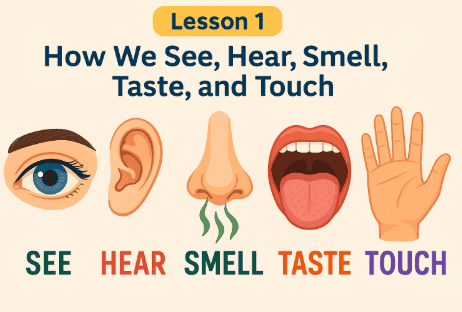
In the last topic, we focused on the spinal cord—the great highway of messages that connects the brain with the body. But messages alone aren’t enough. The brain needs a way to collect information about the outside world.
That’s where the senses come in.
Your senses are like reporters that constantly feed the brain news about what’s happening around you. They let you know:
-
What the world looks like 👀
-
What it sounds like 👂
-
What it smells like 👃
-
What it tastes like 👅
-
What it feels like ✋
Without the senses, the brain would be like a king locked inside a dark, silent castle, unable to know what was happening outside.
Let’s dive into each of the five senses one by one.
👁️ Step 1: Sight – How We See
Your eyes are like cameras, but far more advanced.
-
Cornea: The clear outer layer that bends light as it enters.
-
Lens: A flexible part that focuses light, just like a zoom lens on a camera.
-
Retina: The “film” at the back of the eye that captures the image. It has two types of light sensors:
-
Rods: See black and white in dim light 🌙.
-
Cones: See color in bright light 🌈.
-
-
Optic nerve: The cable that sends the picture to the brain.
Your brain actually flips the image right-side up because the retina records everything upside-down. So, every moment of your life, your brain is like a movie director editing the raw footage from your eyes.
👂 Step 2: Hearing – How We Hear
Your ears don’t just let you hear—they also help you balance (we’ll cover that in the next lesson).
-
Outer ear: Collects sound waves, like a funnel.
-
Eardrum: A thin skin that vibrates when hit by sound waves.
-
Middle ear bones (ossicles): Three tiny bones—the hammer, anvil, and stirrup—that amplify the sound.
-
Cochlea: A snail-shaped inner ear filled with fluid and thousands of tiny hair cells. When sound vibrations reach the cochlea, the fluid moves, the hairs bend, and electrical signals are sent to the brain.
-
Auditory nerve: Carries the signal to the brain, where sound becomes meaningful.
So, your ears turn air vibrations into music, voices, and all the sounds of life 🎶.
👃 Step 3: Smell – How We Smell
Your nose is like a chemical detector.
-
Inside your nose are special receptor cells that can detect tiny molecules in the air.
-
When you sniff, molecules land on these receptors.
-
Each receptor is tuned to different smells, like keys fitting into locks.
-
The signals go to the brain’s olfactory bulb, which then tells you: “That’s fresh bread 🥖” or “That’s smoke 🔥.”
Smell is strongly connected to memory and emotion. That’s why a single scent can bring back a childhood memory instantly.
👅 Step 4: Taste – How We Taste
Your tongue is covered in tiny bumps called taste buds. Inside them are taste receptor cells that detect five main flavors:
-
Sweet 🍭
-
Sour 🍋
-
Salty 🧂
-
Bitter ☕
-
Umami (savory, like meat or soy sauce) 🍲
Taste and smell work together. That’s why when you have a stuffy nose 🤧, food tastes bland—because your brain isn’t getting the smell signals to combine with the taste.
✋ Step 5: Touch – How We Feel
Your skin is your largest sense organ. It has millions of receptors for:
-
Pressure 🖐️ (like a handshake)
-
Temperature 🌡️ (hot or cold)
-
Pain ⚡ (warning signals)
-
Vibration 🔊 (like a phone buzzing)
Some areas, like your fingertips and lips, have many more receptors than others. That’s why you can read Braille with your fingertips, but not with your back.
🌎 Step 6: Why the Five Senses Matter Together
Imagine eating pizza 🍕:
-
You see the melted cheese.
-
You smell the spices.
-
You taste the salty, sweet, sour, and umami flavors.
-
You feel the warmth on your fingers.
-
You hear the crunch of the crust.
Your brain combines all five senses to create the full experience. Life would be very different if even one sense was missing.
📝 Recap of Lesson 1
-
The eyes detect light and color using rods and cones.
-
The ears turn vibrations into sound using the cochlea.
-
The nose detects chemicals in the air, which we call smells.
-
The tongue detects five main flavors with taste buds.
-
The skin senses touch, pressure, pain, and temperature.
-
Together, the five senses give the brain a complete picture of the world.
Next, in Lesson 2, we’ll go beyond the five senses and explore the special senses—balance, pain, and temperature—that also keep us safe and aware.